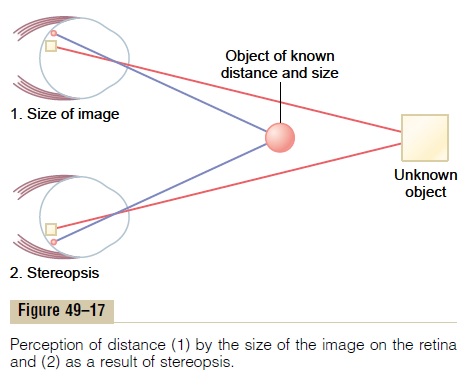Chapter: Medical Physiology: The Eye: I. Optics of Vision
Determination of Distance of an Object from the Eye- ‚ÄúDepth Perception‚ÄĚ
Determination of Distance of an Object from the Eye- ‚ÄúDepth Perception‚ÄĚ
A person normally perceives distance by three major means: (1) the sizes of the images of known objects on the retina, (2) the phenomenon of moving parallax, and (3) the phenomenon of stereopsis. This ability to determine distance is called depth perception.
Determination of Distance by Sizes of Retinal Images of Known Objects. If one knows that a person being viewed is 6feet tall, one can determine how far away the person is simply by the size of the person’s image on the retina. One does not consciously think about the size, but the brain has learned to calculate automatically from image sizes the distances of objects when the dimensions are known.
Determination of Distance by Moving Parallax. Anotherimportant means by which the eyes determine distance is that of moving parallax. If an individual looks off into the distance with the eyes completely still, he or she perceives no moving parallax, but when the person moves his or her head to one side or the other, the images of close-by objects move rapidly across the retinas, while the images of distant objects remain almost completely stationary. For instance, by moving the head 1 inch to the side when the object is only 1 inch in front of the eye, the image moves almost all the way across the retinas, whereas the image of an object 200 feet away from the eyes does not move percepti-bly. Thus, by using this mechanism of moving parallax, one can tell the relative distances of different objects even though only one eye is used.
Determination of Distance by Stereopsis‚ÄĒBinocular Vision.
Another method by which one perceives parallax is that of ‚Äúbinocular vision.‚ÄĚ Because one eye is a little more than 2 inches to one side of the other eye, the images on the two retinas are different from each other. For instance, an object 1 inch in front of the nose forms an image on the left side of the retina of the left eye but on the right side of the retina of the right eye, whereas a small object 20 feet in front of the nose has its image at closely corresponding points in the centers of the two retinas. This type of parallax is demon-strated in Figure 49‚Äď17, which shows the images of a red spot and a yellow square actually reversed on the two retinas because they are at different distances in front of the eyes. This gives a type of parallax that is present all the time when both eyes are being used. It is almost entirely this binocular parallax (or stereop-sis) that gives a person with two eyes far greater abilityto judge relative distanceswhen objects are nearby than a person who has only one eye. However, stereopsis is virtually useless for depth perception at distances beyond 50 to 200 feet.

Related Topics